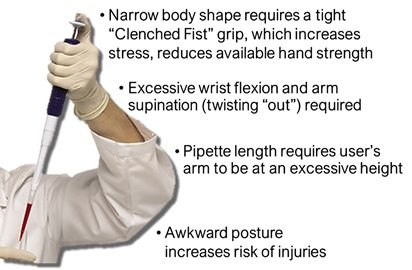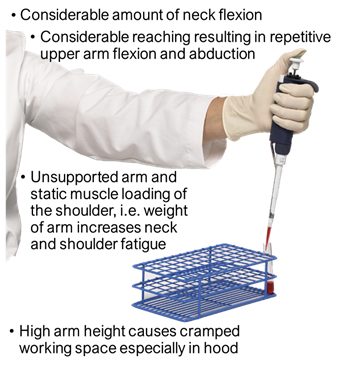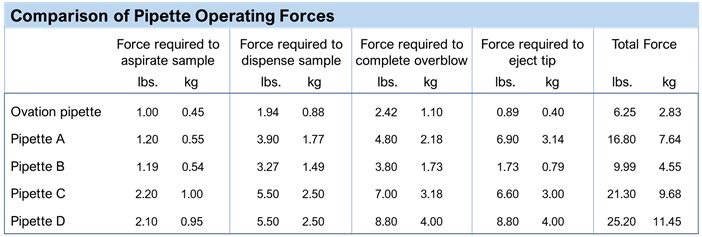Force, simply defined, is the energy required to accomplish a task, and there is a lot more to pipette forces than meets the eye – or the thumb. Aspirating and dispensing are not the only actions in pipetting that requires the use of the thumb muscles. Tip acquisition and ejection usually requires excessive forces that contribute significantly to muscle fatigue. A strong interrelationship also exists between posture and force – as posture deviates from neutral positions, the need for additional exertion increases. Therefore, when considering forces while choosing a pipette, one should focus on the actual muscle exertion that may be required and not only force measurement data.
The use of manual pipettes has long been associated with a high prevalence of upper extremity and neck cumulative trauma disorders (CTDs). One study involving 128 laboratory technicians (M.G. Bjorksten et al, 1994) found that 44% reported hand problems, 58% reported shoulder problems and 44% reported neck problems attributed to pipetting. A similar study (G. David, P. Buckle, 1996) identified significant increases in hand and elbow injuries among pipetters. Separately a Health Hazard Evaluation completed by the National Institute of Safety & Health (NIOSH) stated that “a biomechanical hazard exists from exposure to pipetting operations…”


The neck, shoulder, and elbow stresses are largely driven by the design of the pipettes. The axial shape requires users to raise their hand at least 25.4 cm off the work surface to clear the protruding pipette tip. It is not the weight of the device that causes the problem here; rather, it is the weight of the user’s arm which is often held suspended (static) over the work surface throughout the pipetting tasks. This requirement is the primary source of the upper extremity postural stresses.
Tip Acquisition Forces
The actual forces required to acquire a tip can vary greatly due to a variety of factors, including tip quality, fit dimensions and user technique.
Several tip manufacturers offer “universal” tips designed to fit a variety of pipette brands. This multi-fit capability is usually accomplished using a conical-shaped seal area. The pipette is forced (jammed) into the tip until a seal is formed. In many cases, users perform tapping, and even pounding of the pipette into the tip in an attempt to ensure a proper seal.
From an ergonomic perspective, when jamming, tapping or pounding a pipette into a tip, the user exerts a level of force that is well beyond the pipette’s intended design. While this excess force is considered by some as preferable to a tip falling off during use, the ergonomic effects should not be overlooked.
During tip acquisition with these extra-force actions, the user also needs to tightly grip the pipette to prevent the pipette from slipping. This “clenched fist” grip causes unnecessary tension in the forearm and hand muscles as well as contact stress in the palm of the hand. The forces necessary to remove the tip are also increased. Because the tip is forced onto the pipette, the user needs to apply additional force to the tip ejector mechanism, further increasing exertion by the thumb muscles.
When selecting pipette tips, a comparison of the manufacturer’s recommended tip dimensions and the dimensions of alternate tips should be considered. The selected tip should fit snuggly onto the pipette, ensuring proper sealing with minimal force and without the need to jam or tap or pound the pipette into the tip.
Aspirating and Dispensing Forces
Pipette manufacturers have attempted to reduce plunger spring forces with magnetics or electronic enhancements. Measuring the amount of force required to actuate a pipette’s plunger is rather straightforward and often published by manufacturers. Data on required thumb forces should be considered in conjunction with other ergonomic factors, especially posture, when evaluating overall pipetting stress and force levels.
Tip Removal
Most pipettes have tip ejection mechanisms. However, as mentioned above, if a tip is applied with more force than the pipette’s intended design, the ejection mechanism may require additional force or not work at all. Data on required tip ejection forces should be considered in conjunction with other ergonomic factors when evaluating overall pipetting stress and force levels.
The Ovation Solution
The Ovation Pipette was specifically designed to address each of the force-related concerns.
- A loose, relaxed grip is used in all pipetting operations, including tip acquisition.
- A gentle push of the pipette’s nozzle into a tip is all that’s needed to securely attach a tip.
- An audible “click” provides feedback to confirm that the tip is attached properly. No need for jamming.
- Easy on – easy off. Ovation’s proprietary “energy release” button ejects tips with a gentle push, and low force.
- See more at Ovation Pipette Features
Ergonomic Technologies Corporation, a consulting firm specializing in workplace ergonomics, conducted a series of tests using traditional axial-designed pipettes and VistaLab’s Ovation Pipette. Ovation pipettes requires less force throughout all pipetting tasks. A summary of the various force comparisons discussed above shows a significant reduction in the overall amount of force required when pipetting.

When selecting the best pipette, start by looking at the facts. Ergonomics is a Science, not a Slogan.
The Ovation pipette line of ergonomic pipettes are available in the full range of sizes, single channel Manual models, including Macro Volume, and Electronic models, both single and multichannel. Check them out here!

